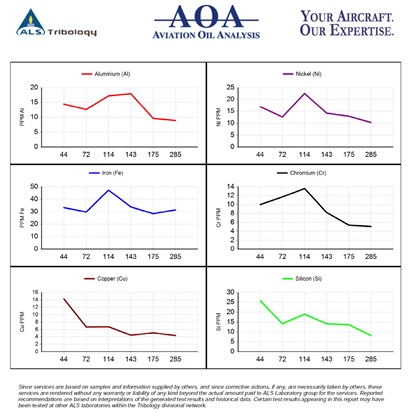Aircraft Maintenance: Understanding oil analysis
In my previous article, I explained how oil filter inspections provide us with objective data and established guidelines to act on. Oil analysis, on the other hand, is all about trends.
Oil analysis traces its roots back to the 1940s when railroad operators used it as a proactive maintenance tool. Back then it was a painstakingly slow process where chemists tested for one metal at a time. It wasn't until the 1960s when spectrometric oil analyzers made analyzing oil efficient enough for widespread use. By the 1970s, it was becoming common enough in aviation use that Lycoming issued Service Letter L171 to help explain its proper application to evaluate the health of aircraft engines.
By doing routine oil analysis on your engine at regular intervals, you can establish a trend history specific to your particular engine. Every engine is different and what is "normal" for a given engine is greatly influenced by the type of engine, type of cylinders, how the aircraft is operated, the type of oil used, where the aircraft is located, and other factors. A single oil analysis report is of limited valve. To get the most from the tool, you need to have as much consistency as possible regarding your oil change intervals, oil type, and operating conditions.

The company you use matters as well. It's best to find an oil analysis company you like and stick with it for consistency. Different companies provide different levels of data reporting, analysis, commentary, and other services. There are many good companies out there, so evaluate cost, convenience, and sample reports to choose the one that's best for you. Personally, I have been using ALS Aviation Oil Analysis for over a decade with good results. The company provides multiple levels of analysis services, including a basic kit for piston engines to track silicon, aluminum, iron, copper, nickel, chromium, and silver; an advanced kit that adds lead, tin, magnesium, boron, calcium, phosphorus, zinc, viscosity, water, and particle quantifier index; and a comprehensive kit that includes microscopic particle examination. For most owners, the basic kit is fine (that's what I use). However, if I'm worried about something specific, I step up to the comprehensive kit and get the lab folks to examine the particles under a microscope for a better understanding of the problem. Be sure to use the kits as directed. Fly the aircraft before sampling and let the oil flow for at least a full minute before taking the sample (be careful not to burn yourself).
If you see a spike in the normal trend for your engine, these are the areas that you would look to as potential sources:
- Iron: cylinders, camshaft, crankshaft, lifters, etc. (Rust on these steel parts will raise the iron level also.)
- Aluminum: pistons, piston pin plugs, engine case fretting, or rotating parts wearing against the case or housings.
- Chromium: piston rings, chrome cylinders, valve guides, and valves.
- Copper: bushings, bearings, brass gears (starter adapters), and oil coolers.
- Nickel: valve guides and nickel cylinders.
- Tin and silver: bearings and bushings.
- Silicon: contaminated air getting past the filter, as well as silicone valve cover gaskets (new gaskets will spike silicon).

Although oil analysis is primarily a trend tool, the companies that provide the services have collected enough data over the years to establish "normal ranges" for most engines. One of my most treasured reference documents is a report I have listing over 100 engine makes and models, along with the 50-hour oil analysis averages. I remain fascinated at how seemingly minor differences in engines can have such different average ppm values for different metals. For example, my report shows that the 50-hour average for aluminum in a Lycoming O-320D2J is around 5.6 ppm, while an O-320E2A averages 15.0 ppm. It's a perfect example of why trend is the key.
Oil analysis is powerful tool when used properly. If you do find a spike in your analysis report, don't panic. Take a step back and look at the big picture: Was the filter clean? Has the aircraft been sitting for a while? Could there have been a problem with the sample? Work with your mechanic to make a logical plan to take it one step at a time and keep you safely in the air. Until next time, I hope you and your families remain safe and healthy, and I wish you blue skies.



